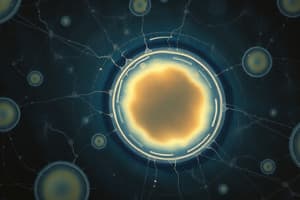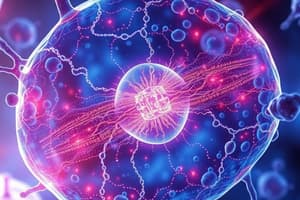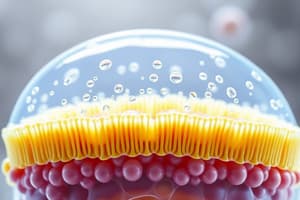Podcast
Questions and Answers
What is the primary function of mitochondria in a cell?
What is the primary function of mitochondria in a cell?
- ATP production (correct)
- Protein synthesis
- Lipid storage
- Cellular secretion
What is the primary function of lysosomes in a cell?
What is the primary function of lysosomes in a cell?
- Protein synthesis
- Energy production
- Digestion of ingested materials (correct)
- Cell division
What is the typical size range of lysosomes?
What is the typical size range of lysosomes?
- 1.0-1.5 um
- 0.5-1.0 um
- 0.75-1.2 um
- 0.25-0.5 um (correct)
What does the term 'cristae' refer to in the context of mitochondria?
What does the term 'cristae' refer to in the context of mitochondria?
What is the significance of the double membrane structure of mitochondria?
What is the significance of the double membrane structure of mitochondria?
Which statement accurately describes centrioles?
Which statement accurately describes centrioles?
How do the dimensions of mitochondria typically compare to other cellular structures?
How do the dimensions of mitochondria typically compare to other cellular structures?
What role does the cytoskeleton play in a cell?
What role does the cytoskeleton play in a cell?
What is produced as a result of aerobic respiration occurring in the mitochondria?
What is produced as a result of aerobic respiration occurring in the mitochondria?
During which process are centrioles critical?
During which process are centrioles critical?
What are lysosomes primarily composed of?
What are lysosomes primarily composed of?
Which of the following correctly describes the role of mitochondria in the transport pathway of cellular materials?
Which of the following correctly describes the role of mitochondria in the transport pathway of cellular materials?
What type of respiration occurs primarily in mitochondria?
What type of respiration occurs primarily in mitochondria?
What type of structures does the cytoskeleton consist of?
What type of structures does the cytoskeleton consist of?
What is the arrangement of centrioles within a cell?
What is the arrangement of centrioles within a cell?
What is one of the key reasons why mitochondrial membranes are similar to plasma membranes?
What is one of the key reasons why mitochondrial membranes are similar to plasma membranes?
What is the primary function of filtration in biological systems?
What is the primary function of filtration in biological systems?
What happens during the G1 phase of interphase?
What happens during the G1 phase of interphase?
Which process requires ATP to transport substances across the cell membrane?
Which process requires ATP to transport substances across the cell membrane?
What is phagocytosis commonly referred to as?
What is phagocytosis commonly referred to as?
Which phase is characterized by the duplication of chromosomes?
Which phase is characterized by the duplication of chromosomes?
What type of transport does pinocytosis correspond to?
What type of transport does pinocytosis correspond to?
In which phase do centrioles move to opposite ends of the cell?
In which phase do centrioles move to opposite ends of the cell?
Which of the following describes exocytosis?
Which of the following describes exocytosis?
What is the overall purpose of meiosis?
What is the overall purpose of meiosis?
What is the role of hydrostatic pressure in filtration?
What is the role of hydrostatic pressure in filtration?
What is NOT a function of interphase?
What is NOT a function of interphase?
During which phase do chromatin condense into chromosomes?
During which phase do chromatin condense into chromosomes?
What primarily distinguishes dialysis from filtration?
What primarily distinguishes dialysis from filtration?
What is considered the control center of the cell?
What is considered the control center of the cell?
Which type of cell transport is most crucial for phagocytes?
Which type of cell transport is most crucial for phagocytes?
Which of the following accurately describes interphase in the cell cycle?
Which of the following accurately describes interphase in the cell cycle?
Which phase continues cell growth and synthesizes proteins necessary for division?
Which phase continues cell growth and synthesizes proteins necessary for division?
What type of transport requires energy expenditure from the cell?
What type of transport requires energy expenditure from the cell?
What marks the end of interphase?
What marks the end of interphase?
Which phase of mitosis involves the alignment of chromosomes at the cell's equator?
Which phase of mitosis involves the alignment of chromosomes at the cell's equator?
During which phase of interphase does chromosomal replication occur?
During which phase of interphase does chromosomal replication occur?
Which of these functions does the plasma membrane NOT perform?
Which of these functions does the plasma membrane NOT perform?
What is the distinction between mitosis and meiosis?
What is the distinction between mitosis and meiosis?
Which organelle is known as the pacemaker of the cell?
Which organelle is known as the pacemaker of the cell?
Flashcards are hidden until you start studying
Study Notes
Cell Organelles and Their Functions
-
Mitochondria: Known as the "Powerhouse of the cell," responsible for producing most ATP through aerobic respiration. They are about 0.2 µm in diameter and 2-6 µm long, featuring double membranes with inner cristae that increase surface area for cellular respiration.
-
Lysosomes: Digestive organelles that act as vesicles to break down ingested material. Slightly smaller than mitochondria, they contain about 60 enzymes that facilitate chemical reactions and the disposal of degraded material.
-
Centrioles: Rod-shaped structures that occur in pairs (Diplosomes/Centrosome), positioned at right angles to each other. They play a crucial role in chromosome movement during cell division, forming the mitotic spindle.
-
Cytoskeleton: An extensive network of protein structures providing internal support, cell shape, and facilitating intracellular transport and cellular movement. Comprised of three types of filaments.
Cell Division Process
-
Interphase: The phase between cell divisions that includes metabolic activity and DNA replication. There are three distinct phases within interphase:
- G1 Phase: The cell grows and metabolizes, but there is no DNA replication.
- S Phase: Chromosomal replication occurs, resulting in identical genetic copies.
- G2 Phase: Pre-Mitotic phase where cell growth continues and proteins are synthesized.
-
Mitosis: The nuclear division process yielding two identical daughter cells, divided into four stages:
- Prophase: Chromatin condenses into chromosomes; centrioles move to opposite poles of the cell.
Transport Mechanisms
-
Filtration: Movement of liquid through a filter, driven by hydrostatic pressure, separating larger molecules from smaller ones in a solution.
-
Dialysis: Involves selective permeable membrane allowing small molecules to pass while retaining larger ones.
-
Active Transport: Requires metabolic energy (ATP) to move substances against a concentration gradient, occurring via processes like:
- Endocytosis: Absorbing extracellular substances into cells by engulfing them.
- Phagocytosis: "Cell eating," engulfing solid particles for immune defense.
- Pinocytosis: "Cell drinking," taking in liquids with dissolved nutrients.
- Endocytosis: Absorbing extracellular substances into cells by engulfing them.
-
Exocytosis: The process of moving substances out of the cell, including the secretion of hormones and removal of waste.
Structure of the Cell
- Cell Components:
- Plasma Membrane: Encloses cytoplasm, provides a selective barrier for substance movement.
- Nucleus: Control center of the cell, containing nucleolus responsible for rRNA synthesis and gene regulation.
- Cytoplasm: Factory area containing organelles and cytosol where cellular activities occur.
Cell Life Cycle
- Cell Division: The process for cell reproduction, including mitosis and meiosis.
- Mitosis: Results in two identical daughter cells through one nuclear division and chromosomal duplication.
- Meiosis: Reduces chromosome number by half, crucial for gamete formation; involves cytokinesis post-division.
Summary of Transport Mechanisms
- Passive Transport: Movement without energy expenditure, classified into:
- Diffusion: Movement from higher to lower concentration.
- Osmosis: Diffusion of water across membranes.
- Filtration and Dialysis: Specialized processes for separating substances in a liquid.
Studying That Suits You
Use AI to generate personalized quizzes and flashcards to suit your learning preferences.




